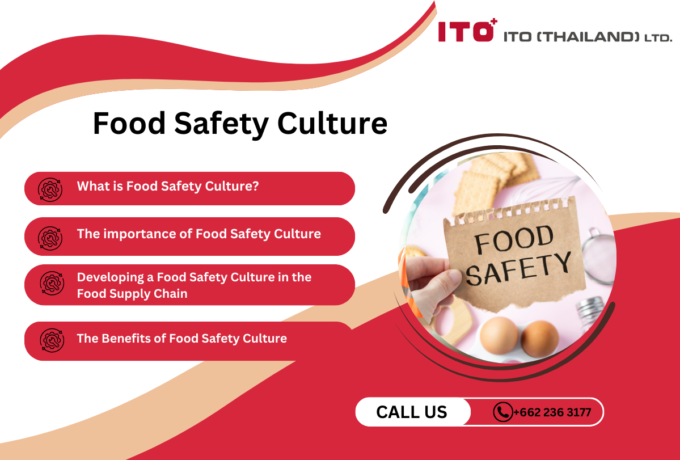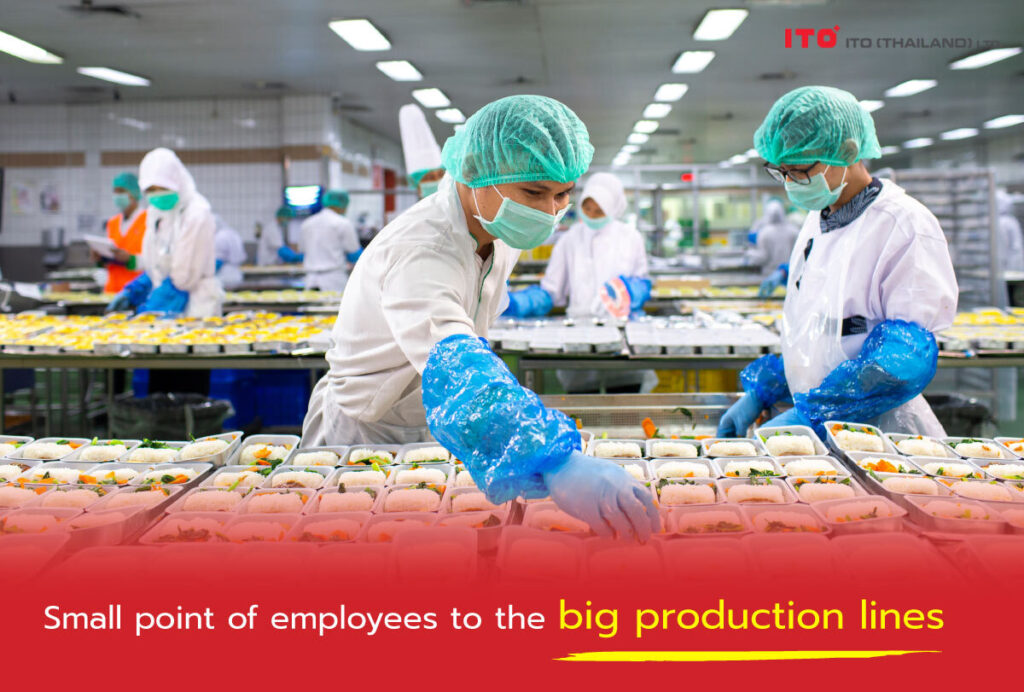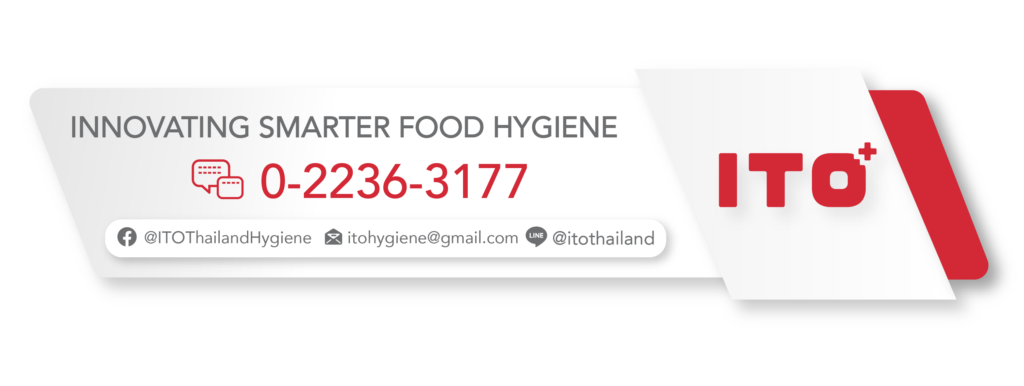ITO Thailand Hygiene Blog
Personal food hygiene – Production staff importance
Setting the foundation from the inside out
Creating a food safety culture is part of the GHP standard that states that it must be implemented as an organization-wide cooperation, ranging from the executives in setting the policy and supporting resources to employees at the operational level. The resources are arranging activities to emphasize the importance of employee engagement in making improvements, providing communication channels for complaints and suggestions, arranging activities to reward those with positive attitude and strong performance to boost their morale and set examples of supporting valuable human resources as well as creating new inspirations to the staff, providing training to enhance the staff’s skills, knowledge, and understanding so that they understand the reason behind following the rules and realize their significance towards product safety. Such training sessions should be, for example, on cross-contamination, proper cleaning and disinfecting methods, microbial growth control, or maintaining aspects of food quality with time, temperature, various factors, and qualities or cautions specific to preparation of each food type – be it fruits, vegetables, or meat, updating the body of knowledge, new standards and technology. There should also be retraining to review the knowledge according to the defined standards (such as annual training) as well as establishing a team responsible for controlling, monitoring, and improving the system continuously.
For the staff to work effectively with a positive attitude, other than incentivization, the daily work environment is also another key factor in promoting the staff’s positive attitude towards the organization. The work environment has to do with, for instance, the cleanliness in the workplace, cleanliness and sufficiency of toilets and canteens, waste management, pests, and order of the workplace, management of noise, air, and water pollution with which the staff must face daily. It also includes the way of work that considers the health and safety of the staff as a priority, such as anti-slippery footwear that protects the staff’s feet, proper chairs, or an area suitable for standing and working long hours, an aid or equipment to help lift heavy things, safety gloves and helmets, jackets for cold storage rooms, maintenance and repair of damaged areas of the building or machines that pose accident risks, the introduction of technology to reduce the workload and enhance efficiency, etc.
Head-to-toe care
In addition to good culture in the organization, setting up rules and regulations for employees to comply with standards may not be new in preventing contamination caused by employee hygiene. However, it is an important foundation that must be emphasized and reviewed regularly. This also applies to the provision of technology equipment to help maintain employee standards better. At present, there are many new technologies that have come into play to help address this point.
•Head
The major of contamination from the head is from the hair. Generally, hygienic standards recommend that employees gather or tie their hair and wear different types of caps or hair nets suitable to the working conditions. Additional tools can also be used to help, such as lint rollers, hair vacuum cleaners, and air showers, etc. In addition to the hair, other contaminants found in the head area are facial hair such as the beard and secretions such as mucus and saliva. Therefore, workers should keep their beard clean and wear a mask suitable to the working conditions.
•Body
Contamination from the body of the staff is often caused by contamination on the staff’s clothing such as dust, animal fur, allergens, dirt, stains from raw materials, or from body hair, especially the arm hair. Therefore, the work clothes should be handled to prevent contamination: cleaning clothes before entering the production line, wearing aprons and gowns, preparing appropriate uniforms such as long sleeves to prevent contamination from arm hair, color-coding by the risk level in each area. Read more. Clothes without buttons or shirt pockets. Cloth-handling includes fabric selection and cleaning and disinfection. In this regard, the policy may be adjusted to suit each product. At present, technology is being used to help examine how the staff are dressed. an AI system captures and processes how employees are dressed, whether they wear a cap or a mask according to the standards.
•Hands
Hands are very important as they are the parts that come in contact with food. Handwashing and disinfection are basic standards generally practiced in the entering of the production line, after returning from a break or bathroom break, during work, after handling trash, dirt, allergens, etc. Nail edges should be handled, and nail polish should be avoided. At present, technology has been introduced to help control the standards of handwashing and disinfection, such as the integration of disinfectant dispensing systems into the entrance doors: the hands must be disinfected before the doors open or using the AI-vision system to ensure that the handwashing gestures meet the defined standards.
•Footwear
Footwear is an important carrier of dirt and other contaminants into the production. Therefore, footwear is generally changed into proper footwear for production, such as boots, ankle boots. Alternatively, shoe covers may be used for visitors. Additional equipment may also be used to clean and disinfect footwear before entering the production area, such as a chlorine disinfection pit, automatic boot cleaners, etc.
Related Post
-

Food Safety Culture
Food safety culture plays a crucial role in safeguarding the company's reputation, ensuring the well-being of its employees, and providing a safe experience for its customers.
-

New food source safety issues
What are safety issues worth knowing for trendy new food sources like plant-based and insect-based proteins?
-

British Retail Consortium (BRC) Standard
Food safety management systems play a vital role in ensuring the production and distribution of safe and high-quality food products to consumers. With the global food supply chain becoming increasingly complex, food businesses must implement effective systems prioritising safety, quality, and compliance with industry standards. A food safety management system encompasses a set of procedures, processes, and controls designed to identify, prevent, and manage potential hazards at every stage of the food production and supply process. This proactive approach not only safeguards consumers' health but also protects the reputation and credibility of food companies in an ever more competitive market.
-

Food Science in the World of Food Gastronomy (Part 1)
How can food science be applied to create new dishes?
-

FSSC 22000
Food manufacturers must ensure food safety standards and processes. FSSC 22000 is an official certification program for Food Safety Management Systems (FSMS) recognised by the Global Food Safety Initiative (GFSI). This certification scheme offers a set of guidelines and procedures to ensure uniformity, openness, and safety across your entire supply chain. It applies to all companies operating within the food and beverage industry, ranging from farmers to retailers. By fulfilling the necessary criteria and obtaining FSSC 22000 certification, it is demonstrated that the required standards for food quality and implementing effective processes to manage and mitigate risks associated with food fraud, foodborne illnesses, expensive recalls, and other external threats are met.
-

Food Safety Aspects of Artificial Sweeteners
Artificial sweeteners, also known as sugar substitutes, non-nutritive sweeteners, or high-intensity sweeteners, are artificially produced compounds utilised in place of sucrose (table sugar) to add sweetness to food and drinks. Due to their significantly higher sweetness than regular sugar, only a fraction of artificial sweeteners (200 to 20,000 times less) is required to achieve an equivalent level of sweetness. Since the caloric contribution of these sweeteners, when used in such small quantities, is insignificant, they are often referred to as non-nutritive (4).










